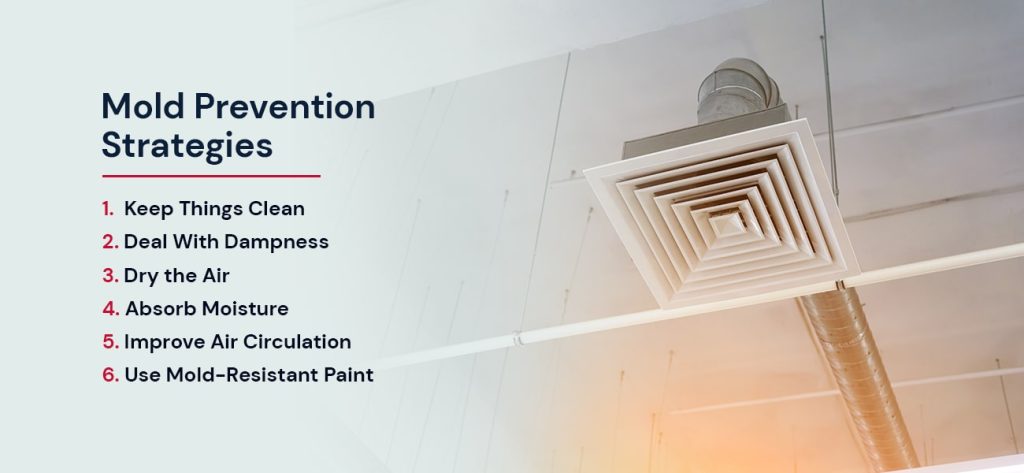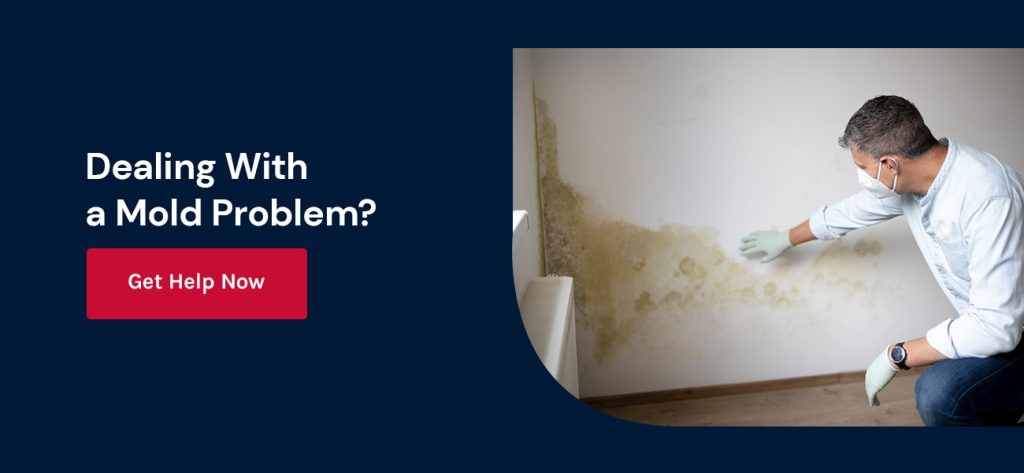With its slimy or fuzzy appearance, mold is an unwelcome visitor in any room. Besides being unsightly, mold can cause significant damage to your commercial building — and the people who work inside it.
If it’s left alone, mold will spread throughout your building. Eventually, once the mold starts to bury inside structures, it will affect the building’s integrity.
If you’re a property manager or commercial property adjuster, it’s important to take the necessary steps to prevent mold and control it as soon as you start seeing signs. Especially if you’re dealing with toxic molds, such as black mold, you don’t want to risk putting the health and safety of the building’s occupants at risk.
Luckily, there are many different ways to get rid of mold in a building.
Mold, which is a type of fungi, can be green, yellow, white or brown. It can also have irregularly textured spots. Besides its noticeable appearance, it also has an earthy, musty smell that can quickly permeate a room.
Mold is commonly found in buildings with high levels of moisture. It thrives in dark, damp environments. Whether there have been heavy rainstorms or flooding in your area or there’s a leak that hasn’t been repaired, any level of water damage can create the perfect setting for mold spores to take over and thrive.
Usually, mold grows the best in areas warmer than 70 degrees Fahrenheit with high humidity. The mold spores can drop on areas like wall paint or plant pots and quickly begin to grow.
It’s also possible for someone to bring mold spores inside unintentionally. Whether mold enters through an open window or your clothing, if spores find a damp spot inside, they will start to feed off the moisture and multiply.
Because of its damaging characteristics, no level of mold is acceptable, which is why you should use professionals to kill mold as soon as possible.

If you’re a property or facility manager, don’t wait until there are visible signs of mold growth to take action. Here are a few commercial mold prevention strategies that can help keep your building safe.
Keep your commercial building as clean as possible. This especially includes areas where mold is likely to grow, ranging from desk drawers to the basement.
Standard cleaning products, like antibacterial dish soap or some undiluted vinegar, keep surfaces clean and help remove any mold that’s starting to form. Ensure you thoroughly dry all surfaces because any dampness can contribute to new mold growth.
If there are any leaks, spills or flooding, it’s important to take care of these issues right away — ideally within 24-48 hours. With enough moisture, mold spores in the air will start to settle onto surfaces. You could quickly experience a mold infestation if you don’t deal with the dampness.
Use highly absorbent rags or a wet vacuum to remove water and dirt. Use soapy detergent and a bristle brush to clean hard surfaces, such as countertops and tile flooring.
Along with getting rid of standing water, it’s also essential to manage the air quality in your commercial building. Whenever there’s damp, poorly circulating air, mold will flourish. Minimizing the moisture in the air can help reduce the chances of mold taking over.
To do this, ensure the building’s air conditioning systems are working as they should. When they are, your systems will help remove some of the moisture from the air by cooling the warm air and then circulating the cool air, which holds less moisture, back into the rooms.
High humidity increases the chances of mold in commercial buildings, so keep the indoor humidity lower than 60%.
While air conditioners can help control some of the humidity, sometimes they aren’t enough. You may also have areas of your building, like the basement, that aren’t air-conditioned at all. Using exhaust fans and dehumidifiers can help absorb moisture and prevent excess humidity.
Be sure to inspect both your heating and cooling systems regularly. Poorly ventilated spaces can quickly get musty and damp if there’s a leak or prolonged wet weather. Ensure your systems can push excess moisture outside and keep the rooms dry. Consider adding a humidistat to your units to help control some of the humidity.
When inspecting your systems, you’ll also want to pay attention to the air ducts. You want them to be clean and in good working order to improve air circulation.
Certain materials, including paint, can support mold growth. Instead of regular paint, consider using specially formulated mold-resistant paint to prevent that from happening.
These paints feature antimicrobial properties that kill mold spores and prevent an infestation. As long as you don’t paint over existing mold, these types of paint will help keep your walls mold-free.
If you’ve been noticing mold in your commercial building or your employees are showing symptoms due to a mold infestation, it’s best to turn to a team of professionals. Attempting to remove mold yourself can be time-consuming and labor-intensive — as well as dangerous.
At URI, we provide mold remediation services to remove all traces of mold from your property. We follow a three-phase approach to get the job done:
As part of our mold restoration process, we also provide:

URI has provided comprehensive commercial mold remediation and restoration services for over 20 years. No matter the extent of your mold infestation, our team is equipped to handle it and get you back in business as soon as possible.
We have several locations throughout the Northeast, Mid-Atlantic and Southeast. If you are in Florida, Maryland, Delaware, New Jersey, Pennsylvania, Virginia or Washington, D.C., we have you covered.
Contact us whenever you need commercial mold restoration services and a fast, 24/7 emergency response. We’re on it!